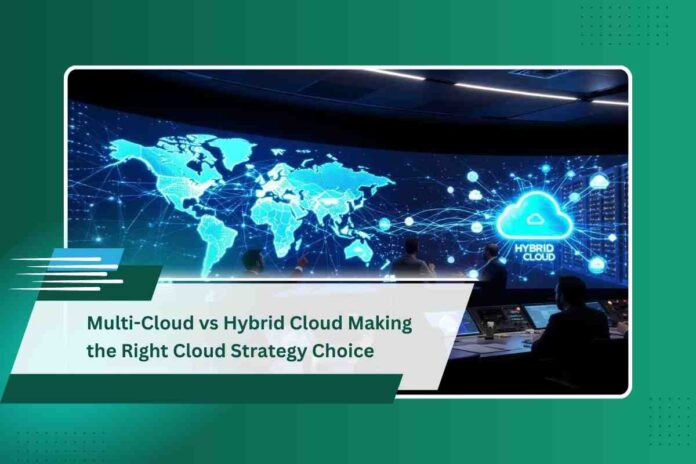In today’s dynamic digital landscape, cloud computing is no longer a futuristic concept it is the backbone of modern IT infrastructure. Organizations are moving away from single-vendor cloud solutions in favor of more flexible, scalable, and resilient architectures. Among the leading approaches are Multi-Cloud and Hybrid Cloud, each offering distinct advantages and challenges. Understanding the differences between the two is essential for making informed technology investments that align with business goals.
While these terms are often used interchangeably, Multi-Cloud and Hybrid Cloud are not the same. They represent different strategies for managing workloads, applications, and data across multiple environments. Selecting the right approach can optimize performance, reduce costs, and improve disaster recovery capabilities if done thoughtfully.
Understanding Multi-Cloud
Multi-Cloud refers to the use of multiple cloud service providers within a single architecture. For example, a business might use Amazon Web Services (AWS) for storage, Microsoft Azure for analytics, and Google Cloud Platform (GCP) for machine learning.
The key benefits of Multi-Cloud include:
- Vendor Diversity
By working with multiple providers, organizations avoid dependency on a single vendor, reducing the risks associated with outages, price changes, or policy shifts. - Performance Optimization
Businesses can select the cloud services best suited for specific workloads, improving efficiency and performance. - Global Reach
Different providers may have better infrastructure in specific regions, reducing latency for end-users. - Disaster Recovery
Storing data and workloads across multiple clouds enhances resilience and ensures service continuity during outages.
Understanding Hybrid Cloud
Multi-Cloud vs Hybrid Cloud Making the Right Cloud Strategy Choice include:
- Data Security and Compliance
Organizations can keep sensitive data in private environments to meet regulatory requirements while still benefiting from public cloud flexibility. - Workload Flexibility
Applications can move between public and private environments as business needs change. - Cost Efficiency
Businesses can run stable workloads in private infrastructure while using public cloud resources for temporary spikes in demand. - Legacy System Integration
Hybrid Cloud allows companies to connect modern applications with legacy on-premises systems without full migration.
Multi-Cloud vs Hybrid Cloud: Key Differences
Although Multi-Cloud and Hybrid Cloud can overlap especially if an organization uses both models they have fundamental differences in structure and purpose.
| Feature | Multi-Cloud | Hybrid Cloud |
| Definition | Use of multiple public cloud providers | Integration of public cloud with private cloud/on-premises |
| Primary Goal | Vendor flexibility and workload optimization | Balancing security with scalability |
| Security Model | Varies by provider | Centralized control over sensitive workloads |
| Infrastructure Complexity | High due to multiple vendor management | Moderate, focused on integration between two environments |
| Use Cases | Best-of-breed solutions, redundancy | Regulatory compliance, hybrid workloads |
When to Choose Multi-Cloud
Multi-Cloud is the right choice if your organization:
- Wants to avoid vendor lock-in.
- Operates in multiple global regions with varying connectivity needs.
- Seeks the best services from each provider for specific workloads.
- Requires high availability and redundancy across providers.
For instance, a global e-commerce company might use one provider’s AI services for personalized recommendations, another’s cloud storage for scalability, and a third’s content delivery network (CDN) for faster customer experiences worldwide.
When to Choose Hybrid Cloud
Hybrid Cloud is the better fit if your business:
- Handles sensitive, regulated data that must remain private.
- Wants to integrate existing on-premises systems with new cloud services.
- Experiences fluctuating workloads that require on-demand scalability.
- Needs to gradually transition to the cloud without full migration.
For example, a healthcare provider may store patient records in a private data center for compliance while running its appointment scheduling system in a public cloud environment for better accessibility and uptime.
The Future of Cloud Strategies: Merging the Two Approaches
Some organizations are adopting strategies that combine Multi-Cloud and Hybrid Cloud models. This results in a hybrid multi-cloud approach where workloads are distributed across public, private, and multiple cloud providers.
This approach can deliver:
- Maximum Flexibility: Leveraging different clouds for different purposes while keeping sensitive workloads secure.
- Enhanced Resilience: Eliminating single points of failure through redundancy across providers and environments.
- Cost Optimization: Balancing long-term private infrastructure investment with pay-as-you-go public services.
However, managing such an environment requires advanced orchestration tools, strong governance policies, and a highly skilled IT team.
Security Considerations for Multi-Cloud and Hybrid Cloud
Security is a top priority for any cloud strategy.
For Multi-Cloud, security challenges often stem from inconsistent policies across different providers. Organizations need centralized monitoring, identity access management (IAM) consistency, and unified threat detection to minimize risks.
For Hybrid Cloud, security revolves around protecting data as it moves between public and private environments. Encrypted connections, API security, and zero-trust architectures are critical.
In both cases, compliance with industry regulations such as GDPR, HIPAA, or PCI DSS must be maintained across all environments.
Best Practices for Choosing the Right Cloud Model
To make the most informed decision between Multi-Cloud and Hybrid Cloud, organizations should:
- Assess Workload Requirements
Identify which workloads require high security, low latency, or specialized services. - Evaluate Compliance Needs
Understand regulatory obligations before deciding where data will reside. - Consider Scalability Goals
Determine if your business will benefit from multi-vendor diversity or secure hybrid integration. - Analyze Cost Structures
Compare total cost of ownership for both models, including management tools and staffing needs. - Plan for Management and Governance
Implement centralized monitoring and automation to simplify operations across environments.
Cloud Choice and Business Growth
Choosing between Multi-Cloud and Hybrid Cloud is not merely a technical decision—it is a strategic business choice. The right model will support innovation, enhance customer experiences, and provide resilience against disruptions.
Forward-thinking companies are already experimenting with both approaches, testing performance under real-world conditions, and refining strategies to match evolving business goals.
Want to explore the right cloud strategy for your organization? Visit iTechinfopro to discover expert insights and solutions tailored to your business needs.


